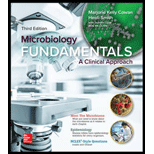
Microbiology Fundamentals: A Clinical Approach
3rd Edition
ISBN: 9781259709227
Author: Marjorie Kelly Cowan Professor, Heidi Smith
Publisher: McGraw-Hill Education
expand_more
expand_more
format_list_bulleted
Concept explainers
Question
Chapter 4.4, Problem 19AYP
Summary Introduction
To enlist:
A disease caused by each of the four types of protozoa.
Concept introduction:
All protozoan organisms are commonly unicellular organisms that can be categorized into three groups on the basis of their mode of motility-pseudopodia-using sarcodina, cilia-using ciliophora, and flagella-using mastigophora. Non-motile protozoa are called sporozoa. Protozoa are dependent on locomotion for their transmission to host organisms, and also for feeding.
Expert Solution & Answer
Want to see the full answer?
Check out a sample textbook solution
Students have asked these similar questions
What is the structure and function of Eukaryotic cells, including their organelles? How are Eukaryotic cells different than Prokaryotic cells, in terms of evolution which form of the cell might have came first? How do Eukaryotic cells become malignant (cancerous)?
What are the roles of DNA and proteins inside of the cell? What are the building blocks or molecular components of the DNA and proteins? How are proteins produced within the cell? What connection is there between DNA, proteins, and the cell cycle? What is the relationship between DNA, proteins, and Cancer?
Why cells go through various types of cell division and how eukaryotic cells control cell growth through the cell cycle control system?
Chapter 4 Solutions
Microbiology Fundamentals: A Clinical Approach
Ch. 4.1 - Relate bacterial, archaeal, and eukaryotic cells...Ch. 4.1 - List the types of eukaryotic microorganisms, and...Ch. 4.2 - Differentiate among the flagellar structures of...Ch. 4.2 - List similarities and differences between...Ch. 4.2 - Describe the main structural components of a...Ch. 4.2 - Diagram how the nucleus, endoplasmic reticulum,...Ch. 4.2 - Prob. 7AYPCh. 4.2 - Explain the importance of ribosomes, and...Ch. 4.2 - List and describe the three main fibers of the...Ch. 4.2 - Prob. 10AYP
Ch. 4.2 - Prob. 1NPCh. 4.3 - Prob. 11AYPCh. 4.3 - Prob. 12AYPCh. 4.3 - Differentiate among the terms heterotroph,...Ch. 4.3 - Prob. 14AYPCh. 4.3 - Prob. 15AYPCh. 4.3 - Q. Yeast infection is one common side effect of...Ch. 4.3 - Prob. 2MMCh. 4.4 - Prob. 16AYPCh. 4.4 - Prob. 17AYPCh. 4.4 - Explain why a cyst stage may be useful to a...Ch. 4.4 - Prob. 19AYPCh. 4.4 - Prob. 2NPCh. 4.5 - Prob. 20AYPCh. 4.5 - Summarize the stages of a typical helminth life...Ch. 4.5 - Prob. 3NPCh. 4.5 - Prob. 3MMCh. 4 - Mitochondria likely originated from a. archaea. b....Ch. 4 - Summarize the endosymbiotic theory and explain how...Ch. 4 - Prob. 3QCh. 4 - Prob. 4QCh. 4 - Compare and contrast the structure and function of...Ch. 4 - Prob. 6QCh. 4 - Prob. 7QCh. 4 - Considering the role of fungi in nature, speculate...Ch. 4 - Prob. 9QCh. 4 - Prob. 10QCh. 4 - Prob. 11QCh. 4 - Prob. 12QCh. 4 - Prob. 13QCh. 4 - Prob. 14QCh. 4 - Do you suppose any of these eukaryotic microbes...Ch. 4 - Which of these groups causes the most casualties...Ch. 4 - Prob. 17QCh. 4 - Do you suspect that the fact that humans use...Ch. 4 - Which of the following is not useful to determine...Ch. 4 - Why were protozoa originally considered a single...Ch. 4 - Write a paragraph that would explain the...Ch. 4 - From chapter 2, figure 2.1. Discuss how the...
Knowledge Booster
Learn more about
Need a deep-dive on the concept behind this application? Look no further. Learn more about this topic, biology and related others by exploring similar questions and additional content below.Similar questions
- In one paragraph show how atoms and they're structure are related to the structure of dna and proteins. Talk about what atoms are. what they're made of, why chemical bonding is important to DNA?arrow_forwardWhat are the structure and properties of atoms and chemical bonds (especially how they relate to DNA and proteins).arrow_forwardThe Sentinel Cell: Nature’s Answer to Cancer?arrow_forward
- Molecular Biology Question You are working to characterize a novel protein in mice. Analysis shows that high levels of the primary transcript that codes for this protein are found in tissue from the brain, muscle, liver, and pancreas. However, an antibody that recognizes the C-terminal portion of the protein indicates that the protein is present in brain, muscle, and liver, but not in the pancreas. What is the most likely explanation for this result?arrow_forwardMolecular Biology Explain/discuss how “slow stop” and “quick/fast stop” mutants wereused to identify different protein involved in DNA replication in E. coli.arrow_forwardMolecular Biology Question A gene that codes for a protein was removed from a eukaryotic cell and inserted into a prokaryotic cell. Although the gene was successfully transcribed and translated, it produced a different protein than it produced in the eukaryotic cell. What is the most likely explanation?arrow_forward
- Molecular Biology LIST three characteristics of origins of replicationarrow_forwardMolecular Biology Question Please help. Thank you For E coli DNA polymerase III, give the structure and function of the b-clamp sub-complex. Describe how the structure of this sub-complex is important for it’s function.arrow_forwardMolecular Biology LIST three characteristics of DNA Polymerasesarrow_forward
arrow_back_ios
SEE MORE QUESTIONS
arrow_forward_ios
Recommended textbooks for you
 Concepts of BiologyBiologyISBN:9781938168116Author:Samantha Fowler, Rebecca Roush, James WisePublisher:OpenStax College
Concepts of BiologyBiologyISBN:9781938168116Author:Samantha Fowler, Rebecca Roush, James WisePublisher:OpenStax College Comprehensive Medical Assisting: Administrative a...NursingISBN:9781305964792Author:Wilburta Q. Lindh, Carol D. Tamparo, Barbara M. Dahl, Julie Morris, Cindy CorreaPublisher:Cengage Learning
Comprehensive Medical Assisting: Administrative a...NursingISBN:9781305964792Author:Wilburta Q. Lindh, Carol D. Tamparo, Barbara M. Dahl, Julie Morris, Cindy CorreaPublisher:Cengage Learning


Concepts of Biology
Biology
ISBN:9781938168116
Author:Samantha Fowler, Rebecca Roush, James Wise
Publisher:OpenStax College


Comprehensive Medical Assisting: Administrative a...
Nursing
ISBN:9781305964792
Author:Wilburta Q. Lindh, Carol D. Tamparo, Barbara M. Dahl, Julie Morris, Cindy Correa
Publisher:Cengage Learning

